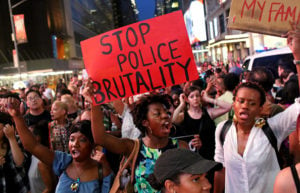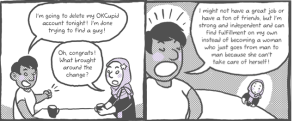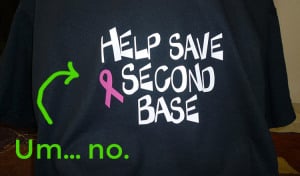Originally published on The Body Is Not An Apology and republished here with permission.

A person of size leans to one side in a chair, having a conversation with someone off-camera.
For most of my life, and especially since coming into a fat identity, I have usually been one of the fattest people – if not the fattest person – in any given room I enter.
When I came into fat activism, I did it operating under the (false) assumption that my experience of fatness was the same (or at least similar, or perhaps comparable) as other fat people’s.
The more my community and conversations expanded – particularly around experiences related to fatness and its intersections with and complications by race, gender, ability, and especially size and shape – the clearer this became.
It would lead to confusion when I would see others I was in community with, others who shared a fat identity, having experiences that I felt weren’t available to me – everything from sex and dating, to clothing and seating, to the ways our bodies were capable of moving.
It took me a long time to unpack how different the fat experience is from body to body.
A product of the fat acceptance movement is a bigger and more diverse group of people embracing their bodies and claiming fat identity. There are so many reasons to claim fatness and so many ways to be fat. It’s an embodiment that is contextual depending on other variations like race, gender, and ability especially.
I don’t think that the destigmatizing and expanding the boundaries of fatness is necessarily a bad thing, but it can become complicated for me when the vast majority of these people are on the smaller end of the spectrum of fatness.
What do I mean by smaller fat people? This is a somewhat ambiguous term and is completely relevant on who is answering. Part of the ambiguity and flexibility of fat identity is that it can be relevant to so many different experiences.
There is no hard and fast rule for this standard, but you might be able to decipher your position on the fat spectrum based on which of these experiences you relate to.
Here is some of the harm caused when fat communities focus on smaller fats.
1. It Reimagines Ideas of Body – But Not Enough
In some ways, this can reify fat stigma and antagonism against larger fat people.
When a bigger range of people begin to identify with fatness, but they all remain in a specific and smaller range, it can work to reformulate ideas of a standard and acceptable body size rather than integrate fat liberationist ideas of bodies and body size.
I can’t count the number of times I’ve seen presumably fat positive articles circulating that are attempting to challenge ideas of fatness. Sometimes they will be claiming to praise the fashion sense of this group of people, or provide proof that fat people can be attractive, too.
Most of the time, these articles are filled with people who are still much, much smaller than me.
Frequently, it can feel like this visibility doesn’t subvert or upend notions of normativity as much as they merely move them slightly to the left – but still exclude and by extension marginalize me as a bigger fat person.
For example, the praise of a “thick” body feels very prevalent right now. Thick is a euphemistic descriptor that comes from African-American Vernacular English to describe bodies that aren’t thin.
The problematics of non-Black folks appropriating the term aside (that’s a whole other article waiting to happen!), in my observation, it’s primarily being used as a nod to body positivity, but by very small people who might fall outside of strict considerations of being skinny, but aren’t the primary targets of fat stigma to reclaim their desirability.
There appear to be limits to those who can be “thick,” though – and therefore, who can still be valued and desirable.
I, for example, would not qualify as “thick” because of my size. This is a very subtle form of fat stigma – one that attempts to appropriate fat positive ideas, but uses them ultimately to reify the praise of thin(ner) bodies.
Often times, instead of challenging notions of body terrorism, visibility that focuses primarily on the smallest – and therefore most privileged – group of people can recreate what fatness should look like, restigmatizing those fat people who don’t look this way.
These spotlights frequently do nothing for, and may harm in this way, folks who are much fatter, have different fat proportions or types of fatness (soft versus hard, not combined with muscularity, not hairy “enough” or “too” hairy, folks with skin conditions, and so on).
2. It Obscures the Thin Privilege That Smaller Fat People Have Access To
Thin privilege is a spectrum.
Over the summer, I moved to a new city where I am in community with a bigger range of fat people, including folks who are fatter than me. This has forced me to reimagine my fat identity, along with my relationship to it. It has also forced me to think about and acknowledge some of my own privileges even as a bigger fat person.
Pants in my size are difficult to come by. I’m at the larger end of the spectrum of many plus-size retailers and some of them don’t even sell my size, but I can still find them. I have to squeeze into chairs with arms and they are not comfortable but I can still fit into them. While I can’t get in and out of cars easily, I can manage and don’t need a seatbelt extender most of the time.
This occurred to me when I caught a ride share up the coast this summer and, on the way, realized it didn’t occur to me to confirm what kind of car the driver had, because I was confident it would be able to accommodate me, even if uncomfortable.
And it did. It was even comfortable.
All of these experiences are much, much different from those bigger than me. And my experiences are much, much different from those who are smaller than me. The abstract category of “fat” can sometimes flatten these differences and imply that, not only are we all having the same experiences under systems of fat hatred, but that we are also not experiencing any privileging based on our size and even shape.
3. It Forgives the Fat Hatred of Smaller Fat People
One of the limits of identity is that, frequently, by claiming one, people allow it to alleviate themselves of the responsibility to continuing to do any work – and forecloses their acknowledgement of a potential to perpetuate harm within community and identities.
We see the effects of this when anti-Blackness in spaces that are for all people of color and transmisogyny in LGBTQIA+ spaces go not only unchecked, but are frequently woven into the fabric of them.
The taking up of a fat identity, while it can be empowering, doesn’t always motivate people to continue to work on their internalized fat hatred.
This is especially true when thinking beyond their own body, or how they might perpetuate fat hatred against bigger fat people. Microaggressions from smaller fat people can feel especially betraying.
While fat identity is relevant to a variety of experiences, it shouldn’t convince smaller fat people that they can no longer perpetuate this harm.
We all have obligations to continue working on ourselves, so that we can liberate not only ourselves but everyone.
4. It Erases Those Who Bear the Brunt of Fat Stigma and Hatred
Ultimately, though, it centers the conversation around people who aren’t always the most immediately targeted by institutional fat stigma and hatred.
Focusing on smaller fat people not only redefines what fatness is, but also obscures the goals necessary to achieve justice for those most affected by fat stigma.
By focusing on and centering those who are most likely to experience street harassment, negligent medical care, wage discrimination, and other avenues of the most violent forms of fat stigma, we can liberate us all.
***
I support folks identifying in ways that make them feel good and best in their body. I believe that the destigmatizing of fatness is not only beneficial, but ultimately integral to the long term goals of fat liberation.
But while we expand the definitions and boundaries of fatness, and continue to work towards fat liberation for all, we need to keep holding ourselves accountable, being aware of our positions, and loving and supporting those more vulnerable than us by being aware of the space we take up and the spaces we create.
[do_widget id=’text-101′]
Caleb Luna is a Contributing Writer for Everyday Feminism. They are working class, fat, brown, queer, living, writing, performing, and dancing in Oakland, California. They are a first-year PhD student at University of California, Berkeley, and their work explores the intersections of fatness, desire, fetishism, white supremacy, and colonialism from a queer of color lens. You can find more of their writing on Black Girl Dangerous and on Facebook and Tumblr under queerandpresentdanger.
Search our 3000+ articles!
Read our articles about:
Our online racial justice training
Used by hundreds of universities, non-profits, and businesses.
Click to learn more




















